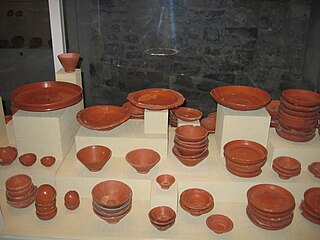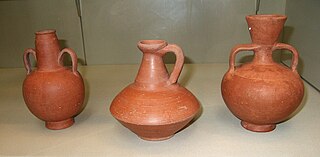
Roman Britain was the area of the island of Great Britain that was governed by the Roman Empire, from 43 to 410 AD. It comprised almost the whole of England and Wales and, for a short period, southern Scotland.

The 5th century is the time period from 400 to 500 Anno Domini (AD) or Common Era (CE) in the Julian calendar. The 5th century is noted for being a period of migration and political instability, throughout Eurasia.

The Iazyges (singular Iazyx, were an ancient Sarmatian tribe that traveled westward in c. 200 BC from Central Asia to the steppes of what is now Ukraine. In c. 44 BC, they moved into modern-day Hungary and Serbia near the Dacian steppe between the Danube and Tisza rivers, where they adopted a semi-sedentary lifestyle.
Howard Hayes Scullard FBA, FSA was a British historian specializing in ancient history, notable for editing the Oxford Classical Dictionary and for his many books.

Africa Proconsularis was a Roman province on the northwest African coast that was established in 146 BC following the defeat of Carthage in the Third Punic War. It roughly comprised the territory of present-day Tunisia, the northeast of Algeria, and the coast of western Libya along the Gulf of Sirte. The territory was originally inhabited by Berber people, known in Latin as Mauri indigenous to all of North Africa west of Egypt; in the 9th century BC, Phoenicians built settlements along the Mediterranean Sea to facilitate shipping, of which Carthage rose to dominance in the 8th century until its conquest by the Roman Republic.

Hans Dragendorff was a Baltic German scholar who introduced the first classification system for the type of Ancient Roman pottery known as Samian ware or Terra sigillata, in 1896, using type numbers. His scheme was based on the varying forms the vessels took and although it has since been augmented and refined by others, it is still common to refer to 'Dragendorff type 37' bowls for example.

La Graufesenque is an archaeological site 2 km from Millau, Aveyron, France, at the confluence of the rivers Tarn and Dourbie. As Condatomagus, it was famous in the Gallo-Roman period for the production of high quality dark red terra sigillata Roman pottery, which was made in vast quantities and exported over much of the western part of the Roman Empire.
Lily Ross Taylor was an American academic and author, who in 1917 became the first female Fellow of the American Academy in Rome.

African red slip ware, also African Red Slip or ARS, is a category of terra sigillata, or "fine" Ancient Roman pottery produced from the mid-1st century AD into the 7th century in the province of Africa Proconsularis, specifically that part roughly coinciding with the modern country of Tunisia and the Diocletianic provinces of Byzacena and Zeugitana. It is distinguished by a thick-orange red slip over a slightly granular fabric. Interior surfaces are completely covered, while the exterior can be only partially slipped, particularly on later examples.

Pottery was produced in enormous quantities in ancient Rome, mostly for utilitarian purposes. It is found all over the former Roman Empire and beyond. Monte Testaccio is a huge waste mound in Rome made almost entirely of broken amphorae used for transporting and storing liquids and other products – in this case probably mostly Spanish olive oil, which was landed nearby, and was the main fuel for lighting, as well as its use in the kitchen and washing in the baths.
Elbows Out is the name given to an Attic black-figure vase painter, active in Athens around 550/540 to 520 BC. His conventional name is derived from the strongly exaggerated gestures and odd anatomy of his dancing figures. Together with the Affecter, he is considered one of the mannerists of the black-figure style. He painted e.g. lip cups and neck amphorae, the latter in a special shape with a heavy ovoid body. His amphorae are decorated with several friezes. His band cups resemble works by Tleson and Lydos, but are more conventional in terms of the animal motifs. He also painted a lydion, a vase shape very rarely produced by Attic potters. He is often seen as connected with the Affecter, but also with the Amasis Painter. The link with the latter should not be overestimated.
Phocaean red slip (PRS) is a category of terra sigillata, or "fine" Ancient Roman pottery produced in or near the ancient city of Phokaia in Asia Minor. It is recognizable by its thin reddish slip over a fine fabric, often with occasional white (lime) inclusions. The main period of production is the late 4th century AD into the 7th century, contemporary to the later production of African red slip. All forms are open bowls or dishes. Later forms have stamped decoration.

Tiddis was a Roman city that depended on Cirta and a bishopric as Tiddi, which remains a Latin Catholic titular see.
Brenda Dickinson is a British archaeologist. She is a leading scholar in the study of Roman pottery, and a specialist in Roman potter's stamps.
















